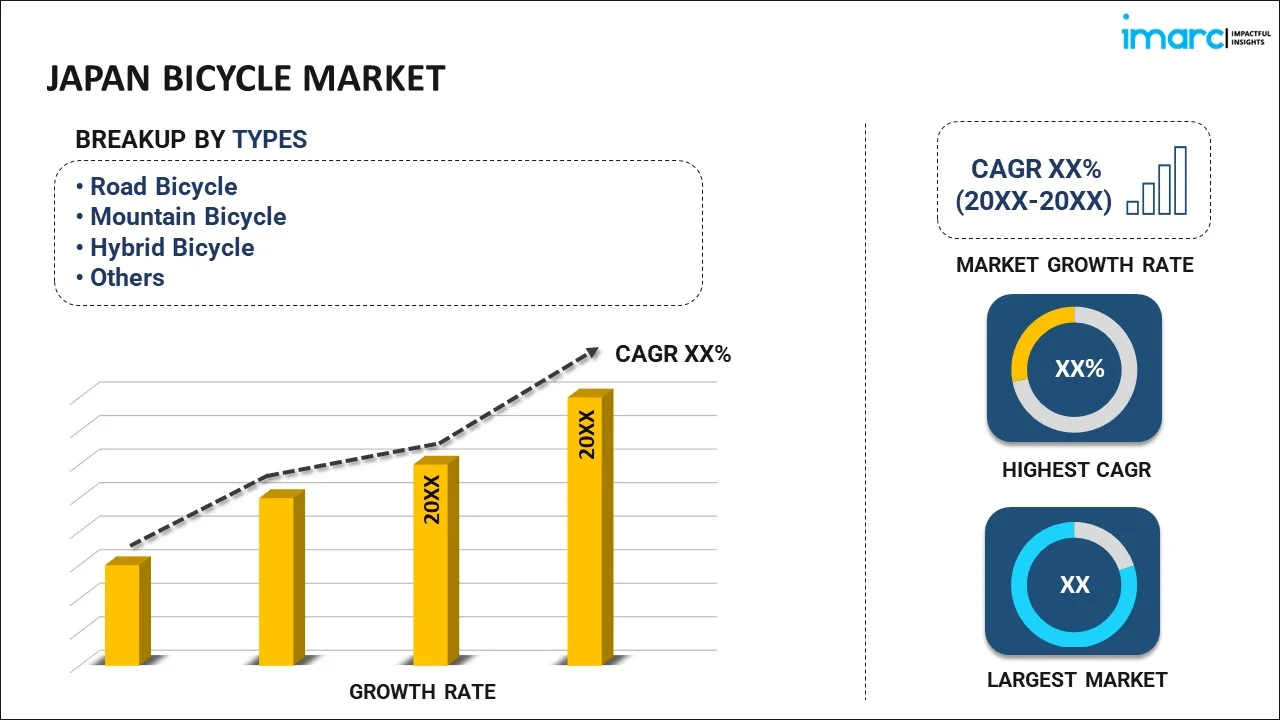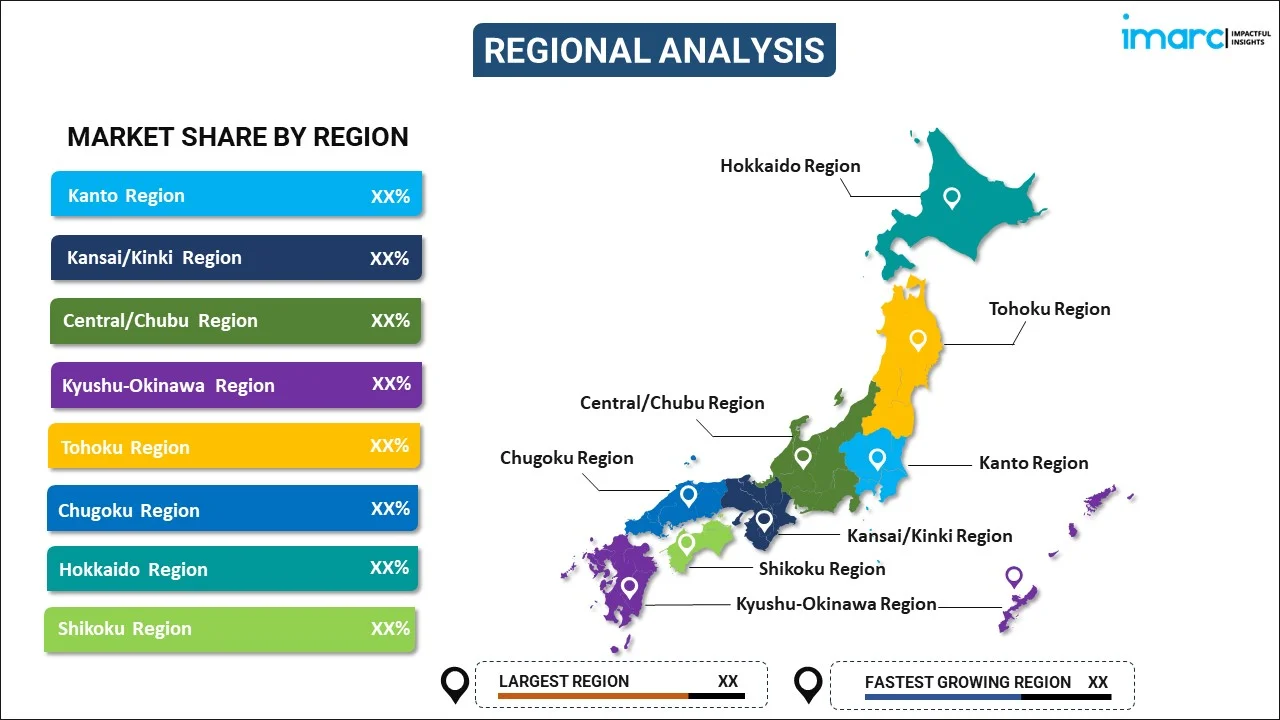
Japan Bicycle Market Report by Type (Road Bicycle, Mountain Bicycle, Hybrid Bicycle, and Others), Technology (Electric, Conventional), Price (Premium, Mid-Range, Low-Range), Distribution Channel (Online Stores, Offline Stores), End User (Men, Women, Kids), and Region 2025-2033
Market Overview:
The Japan bicycle market size reached USD 3,986.1 Million in 2024. Looking forward, IMARC Group expects the market to reach USD 4,495.0 Million by 2033, exhibiting a growth rate (CAGR) of 1.34% during 2025-2033. The growing environmental consciousness, urban congestion, stringent government initiatives, rising trends of health and wellness, rapidly expanding tourism industry, significance of cycling in the Japanese culture, and improving economic factors represent some of the key factors driving the market.
|
Report Attribute
|
Key Statistics
|
|---|---|
|
Base Year
|
2024
|
|
Forecast Years
|
2025-2033
|
|
Historical Years
|
2019-2024
|
| Market Size in 2024 | USD 3,986.1 Million |
| Market Forecast in 2033 | USD 4,495.0 Million |
| Market Growth Rate 2025-2033 | 1.34% |
A bicycle, also known as a bike, is a human-powered vehicle consisting of a frame mounted with two wheels, one in the front and one in the rear, connected by a system of pedals and a chain. It is one of the most popular and efficient modes of transportation, valued for its simplicity and eco-friendliness. The basic components of a bicycle include a frame, handlebars, wheels, tires, brakes, and gears (in some models). Bicycles come in various types, such as road bikes, mountain bikes, and hybrid bikes, each designed for specific purposes and terrains. Bicycles offer numerous advantages, including being a cost-effective and environment-friendly means of travel. They promote physical fitness and are an excellent way to reduce carbon emissions and traffic congestion in urban areas. Moreover, bicycles are often used for recreational purposes, such as cycling for exercise or leisure.
Japan Bicycle Market Trends:
Japan has a strong commitment to environmental sustainability. As a result, there is a growing emphasis on reducing carbon emissions and promoting eco-friendly modes of transportation. Bicycles, being emissions-free and energy-efficient, align perfectly with this ethos, encouraging more people to opt for cycling as a green transportation alternative. Additionally, numerous Japanese cities face issues related to traffic congestion and limited parking spaces. Bicycles offer a practical solution to these problems as they are compact, easily maneuverable in tight spaces, and can be parked conveniently. This makes cycling an attractive choice for urban commuters. Other than this, there is a growing awareness about the importance of a healthy lifestyle in Japan. Cycling is seen as an excellent way to maintain fitness, and this perception drives demand for bicycles, especially among the health-conscious population. Besides this, the beautiful landscapes and scenic routed of Japan make it a popular destination for bicycle tourism. Tourists from around the world visit Japan to explore the countryside and cities on two wheels. This boosts the demand for high-quality bicycles and related services. In line with this, cycling is deeply rooted in Japanese culture. Bicycles are commonly used for daily commuting, and cycling clubs and events are popular. This cultural affinity for cycling contributes to the stability of the market. Furthermore, the cost of owning and maintaining a car in Japan is relatively high, which encourages people to choose bicycles as a more cost-effective means of transportation, especially for short trips. Apart from these factors, the Japanese bicycle market benefits from continuous technological innovations. Japanese companies are known for their cutting-edge designs and advanced features in bicycles, which attract consumers looking for the latest in cycling technology. Moreover, the Japanese government has implemented various initiatives to promote cycling. This includes the development of dedicated bicycle lanes, subsidies for electric bicycles, and safety campaigns to encourage responsible cycling. These efforts contribute to a safer and more attractive cycling environment.
Japan Bicycle Market Segmentation:
IMARC Group provides an analysis of the key trends in each segment of the market, along with forecasts at the country level for 2025-2033. Our report has categorized the market based on type, technology, price, distribution channel and end user.
Type Insights:

To get more information on this market, Request Sample
- Road Bicycle
- Mountain Bicycle
- Hybrid Bicycle
- Others
The report has provided a detailed breakup and analysis of the market based on the type. This includes road bicycle, mountain bicycle, hybrid bicycle, and others.
Technology Insights:
- Electric
- Conventional
A detailed breakup and analysis of the market based on the technology have also been provided in the report. This includes electric and conventional.
Price Insights:
- Premium
- Mid-Range
- Low-Range
The report has provided a detailed breakup and analysis of the market based on the price. This includes premium, mid-range, and low-range.
Distribution Channel Insights:
- Online Stores
- Offline Stores
A detailed breakup and analysis of the market based on the distribution channel have also been provided in the report. This includes online stores and offline stores.
End User Insights:
- Men
- Women
- Kids
The report has provided a detailed breakup and analysis of the market based on the end user. This includes men, women, and kids.
Regional Insights:

- Kanto Region
- Kansai/Kinki Region
- Central/ Chubu Region
- Kyushu-Okinawa Region
- Tohoku Region
- Chugoku Region
- Hokkaido Region
- Shikoku Region
The report has also provided a comprehensive analysis of all the major regional markets, which include Kanto Region, Kansai/Kinki Region, Central/ Chubu Region, Kyushu-Okinawa Region, Tohoku Region, Chugoku Region, Hokkaido Region, and Shikoku Region.
Competitive Landscape:
The market research report has also provided a comprehensive analysis of the competitive landscape. Competitive analysis such as market structure, key player positioning, top winning strategies, competitive dashboard, and company evaluation quadrant has been covered in the report. Also, detailed profiles of all major companies have been provided.
Japan Bicycle Market News:
- January 2025: Velo-city was set to conduct ‘cycling summit’ in Japan. The European Cyclists’ Federation (ECF) declared Ehime Prefecture, recognized as Japan's most bicycle-friendly area, as the venue for the event. Renowned for its vibrant culture and scenic landscapes, the prefecture's cycling initiative emphasized the values of promoting ‘well-being,’ ‘meaningful living,’ and ‘connections.’ Bicycles serve as a sustainable form of transport and are an excellent method for improving health, fostering a sense of purpose in life, and developing new friendships.
- January 2025: The Hello Cycling bike rental application was set to organize a collaborative event with Genshin Impact in Japan. Themed bicycles would be introduced in select Japanese cities, with the campaign running from February 1 to March 31, 2025. Around 10,000 Hello Cycling stations would feature in two national rankings during February and March 2025, with the number of stations visited per user being counted, and the top 20 participants would be awarded unique merchandise.
- November 2024: The Mynavi Tour de Kyushu 2024, an international cycling road race, took place over four days, featuring around 100 cyclists from 17 teams, both domestic and overseas, in the competition. The stage race spanned a total of 387 kilometers across Fukuoka, Oita, and Kumamoto prefectures in Japan. Spectators congregated by the roadside in every location, relishing the thrilling bicycle competition.
Japan Bicycle Market Report Coverage:
| Report Features | Details |
|---|---|
| Base Year of the Analysis | 2024 |
| Historical Period | 2019-2024 |
| Forecast Period | 2025-2033 |
| Units | Million USD |
| Scope of the Report | Exploration of Historical and Forecast Trends, Industry Catalysts and Challenges, Segment-Wise Historical and Predictive Market Assessment:
|
| Types Covered | Road Bicycle, Mountain Bicycle, Hybrid Bicycle, Others |
| Technologies Covered | Electric, Conventional |
| Prices Covered | Premium, Mid-Range, Low-Range |
| Distribution Channels Covered | Online Stores, Offline Stores |
| End Users Covered | Men, Women, Kids |
| Regions Covered | Kanto Region, Kansai/Kinki Region, Central/ Chubu Region, Kyushu-Okinawa Region, Tohoku Region, Chugoku Region, Hokkaido Region, Shikoku Region |
| Customization Scope | 10% Free Customization |
| Post-Sale Analyst Support | 10-12 Weeks |
| Delivery Format | PDF and Excel through Email (We can also provide the editable version of the report in PPT/Word format on special request) |
Key Benefits for Stakeholders:
- IMARC’s industry report offers a comprehensive quantitative analysis of various market segments, historical and current market trends, market forecasts, and dynamics of the Japan bicycle market from 2019-2033.
- The research report provides the latest information on the market drivers, challenges, and opportunities in the Japan bicycle market.
- Porter's five forces analysis assist stakeholders in assessing the impact of new entrants, competitive rivalry, supplier power, buyer power, and the threat of substitution. It helps stakeholders to analyze the level of competition within the Japan bicycle industry and its attractiveness.
- Competitive landscape allows stakeholders to understand their competitive environment and provides an insight into the current positions of key players in the market.
Key Questions Answered in This Report
The bicycle market in Japan was valued at USD 3,986.1 Million in 2024.
The Japan bicycle market is projected to exhibit a CAGR of 1.34% during 2025-2033, reaching a value of USD 4,495.0 Million by 2033.
As more people in urban areas are seeking alternatives to cars and public transport, bicycles are offering a convenient and affordable solution for daily commuting. The government's support for cycling infrastructure, such as bike lanes and parking spaces, is further encouraging bicycle usage. Additionally, the rise in fitness consciousness is motivating people to employ bicycles for exercise and recreation.
Need more help?
- Speak to our experienced analysts for insights on the current market scenarios.
- Include additional segments and countries to customize the report as per your requirement.
- Gain an unparalleled competitive advantage in your domain by understanding how to utilize the report and positively impacting your operations and revenue.
- For further assistance, please connect with our analysts.
 Request Customization
Request Customization
 Speak to an Analyst
Speak to an Analyst
 Request Brochure
Request Brochure
 Inquire Before Buying
Inquire Before Buying




.webp)




.webp)












